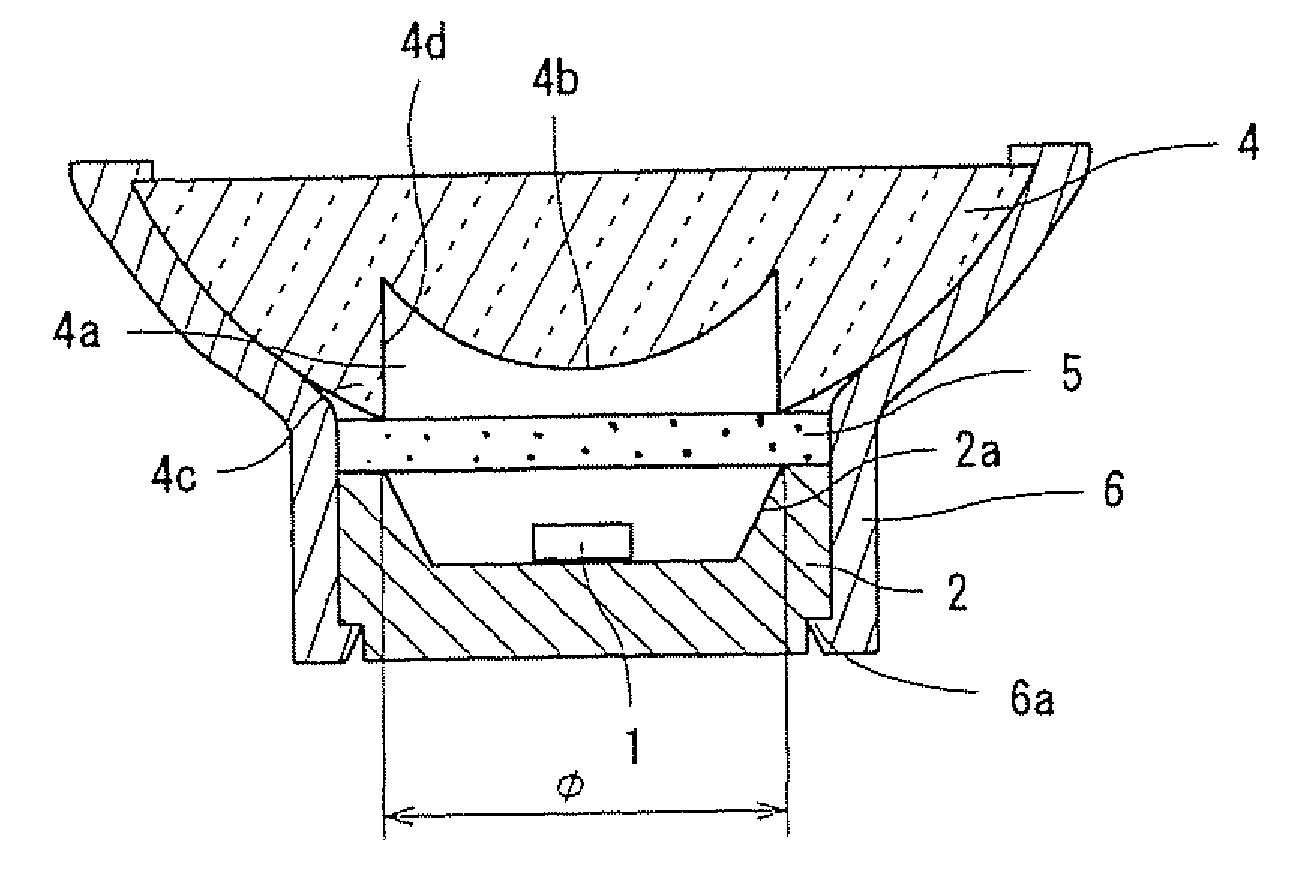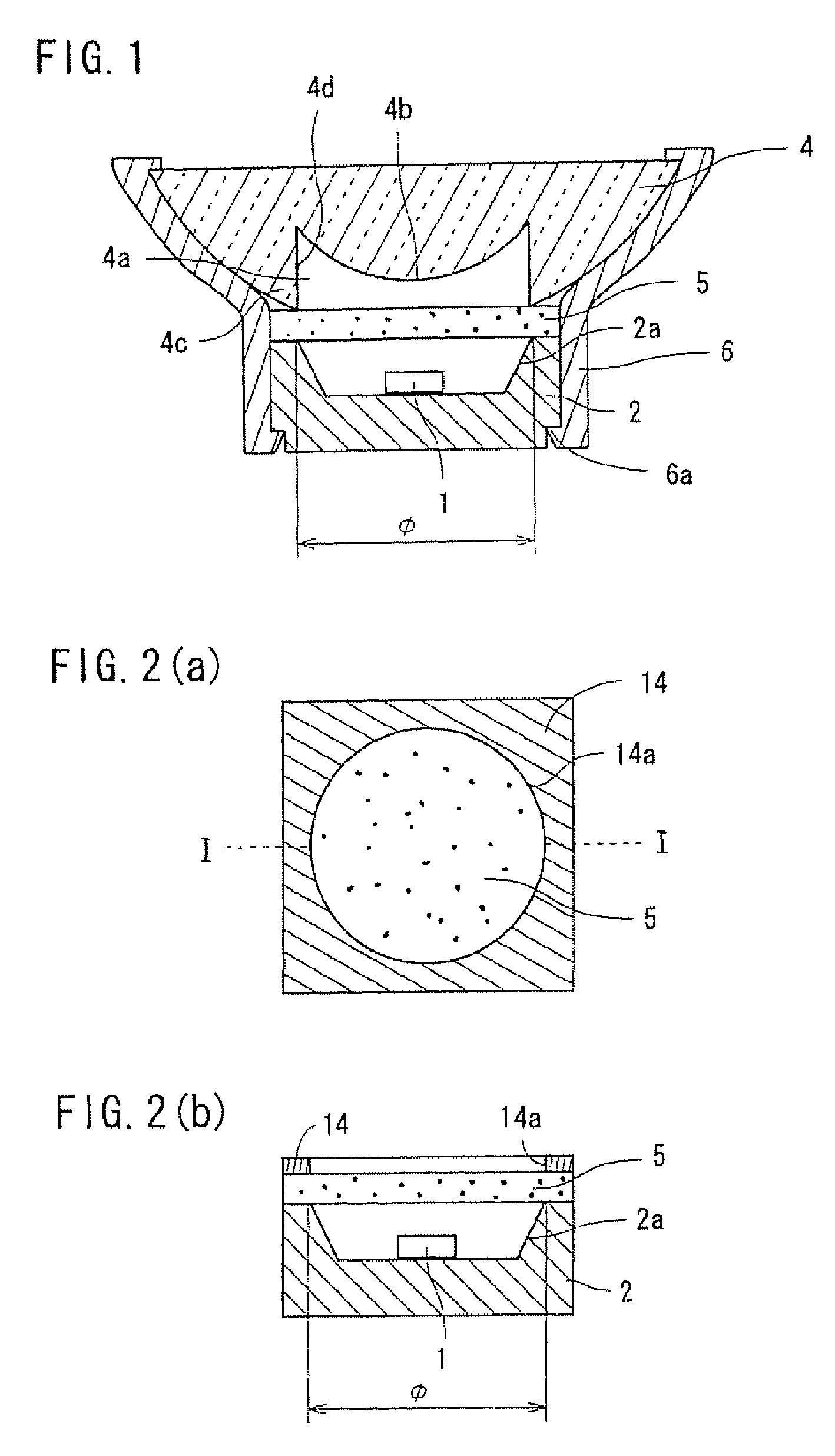Light emitting device using light emitting diode chip
- Summary
- Abstract
- Description
- Claims
- Application Information
AI Technical Summary
Benefits of technology
Problems solved by technology
Method used
Image
Examples
first embodiment
[0056]FIG. 1 shows the schematic configuration of a light emitting device according to a first embodiment. This light emitting device comprises: an LED chip 1: a mounting substrate 2 having a recess 2a in which the LED chip 1 is mounted; a sheet-like wavelength converting member 5 disposed so as to cover the recess 2a and the area around the recess; and a hybrid lens 4 provided at the light output side of the wavelength converting member 5 to function as an emission control member that allows light coming from an area of the wavelength converting member corresponding to the recess 2a to be emitted therefrom. The LED chip 1 is mounted on the bottom of the recess 2a in the mounting substrate 2. The recess 2a has a circular cross section and has a tapered wall. The hybrid lens 4 as the emission control member is provided for preventing uneven color from appearing due to the difference in color between light emitted from the central area of the wavelength converting, member 5 and light ...
second embodiment
[0062] FIGS. 2(a) and 2(b) show the schematic configuration of a light emitting device according to a second embodiment. In place of the optical member as the emission control member used in the above described light emitting device according to the first embodiment, this light emitting device has a frame member 14 made of a light blocking material at the light output side of a wavelength converting member 5. The other components are configured similar to those in the first embodiment. The frame member 14 has an opening 14a corresponding to the recess 2a. The end of the opening 14a has substantially the same shape (diameter φ) as the open end of the recess 2a. This embodiment also achieves an effect equivalent to that of the above embodiment. More particularly, in this embodiment, light emitted from the edge area of the wavelength converting member 5 can be blocked for prevention of unevenness of color.
third embodiment
[0063]FIG. 3 shows the schematic configuration of a light emitting device according to a third embodiment. This light emitting device is configured similar to the second embodiment except that it uses a wavelength converting member 5 with high elasticity. More particularly, silicone resin with high elasticity is used as the light transmissive material. A frame member 14 is pressed against the wavelength converting member 5, whereby part of the wavelength converting member 5 that is located on the edge area around the recess 2a is compressed. The frame member 14 pressing the wavelength converting member 5 is fixed to a mounting substrate 2 with a claws 14b, which is formed at the under side of the frame member 14, being engaged in a groove 2b formed in the side face of the mounting substrate 2.
[0064] This embodiment not only achieves the above described effect but also makes it hard for light within the wavelength converting member 5 to be propagated to the area of the member 5 that...
PUM
 Login to View More
Login to View More Abstract
Description
Claims
Application Information
 Login to View More
Login to View More - R&D
- Intellectual Property
- Life Sciences
- Materials
- Tech Scout
- Unparalleled Data Quality
- Higher Quality Content
- 60% Fewer Hallucinations
Browse by: Latest US Patents, China's latest patents, Technical Efficacy Thesaurus, Application Domain, Technology Topic, Popular Technical Reports.
© 2025 PatSnap. All rights reserved.Legal|Privacy policy|Modern Slavery Act Transparency Statement|Sitemap|About US| Contact US: help@patsnap.com



